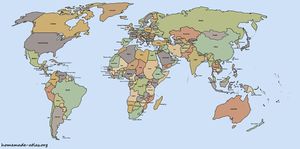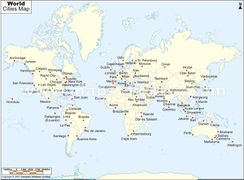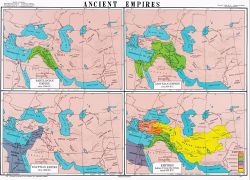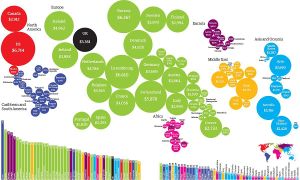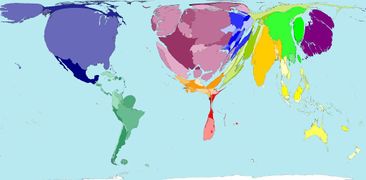The origins and evolution of States
What is a "state"?
Despite the political and social transformations observed since the end of the Cold War with the challenges of transnational corporations, social movements and the emergence of cities as political organizations, the State remains the primary organization. Most of what determines standards and rules originates in the state.
This map is the vision of the world divided into states. Issues such as the emergence of a new state, the division of an existing state seems difficult to resolve. According to UN statistics among the list of 206 sovereign states, 16 are contested like Palestine, Armenia, the two Koreas. There are more and more independence movements such as in Scotland.
The modern state is a fairly recent appearance. The first political organization in terms of state was rather in the form of a city. Outside the city-state, empires were known as political organization. The evolution of States raises the question of whether it is really possible to explain the emergence of States by a single theory. Generally, the answer is "no" because there is a diversity of states. Instead of trying to advance a single theory of emergence, the emphasis is on training processes.
The definitions of States as they exist are extremely broad:
- Painter and Jeffrey in Political Geography: An Introduction to Space and Power published in 2009 propose a broad definition:"(1) complex networks of relationships between a changing set of institutions and social groups; (2) the product of their own processes of institutional development and historical change.
- In Coercion, Capital, and European States published in 1990, Tilly also proposes a broad definition: "organisations other than family groups, exercising coercion and having clear priority over all other organisations within a substantial territory".
Many authors wonder whether the state is a myth, an idea or a social construct. On the one hand the answer can be "no", on the other hand a qualified "yes" from the perspective that myths can be understood as social phenomena that give structure to everyday practices. The State manifests itself and is translated by our habits and practices in everyday life. When you cross a border, you bring a state into existence. According to Painter and Jeffrey, the state is not unified, but the effect of social processes makes it appear that the object exists.
From a political geography perspective, Painter and Jeffrey identify five characteristics :
- precise boundaries;
- substantial territories, administered through territorial institutions such as, for example, local and regional governments;
- an institutional geography that translates into the location of agencies, parliaments, courts, military bases, etc...;
- a state apparatus that allows it to monitor, govern and try to control the population;
- although never complete, surveillance has always tended to increase.
Origines des États
Cadre explicatif
To try to systematize the emergence and formation of States, we must refer to Charles Tilly who introduced in Coercion, Capital, and European States published in 1990 a diagram in order to divide the different explanations. He asks two questions:
- Is the formation of the state independent or is it derived from the economy?
- Does the influence on the formation of states come from inside or outside?
Through these two questions, which bring together the main factors, we have a diagram that allows us to target the explanations.
State theories are the most popular among historians. Training is considered independent of the economy according to internal factors. Political change is seen as precedent to economic change and the institutionalization of the state is the product of internal factors such as the preparation and conduct of war. For example, Samuel Huntington talks about "cultural differences" while Paul Kennedy talks about "unequal economic growth".
Geopolitical theories are theories that consider that the formation of states is independent of the economy, but this time the factors that drive the formation of states come from outside. State formation is a response to the international system. James Rosenau identifies four types of response: consenting, intransigent, promotional, conservative. These responses have different implications for state dimensions.
The theories of the mode of production emphasize the mechanisms of feudalism, mercantilism or capitalism within a Marxist perspective. For example, Perry Anderson studies the relations between aristocrats, peasantry and cities. The impetus for state formation comes from outside.
The theory of the world system postulates that sovereignty must be built through an interstate system of mutual recognition. Immanuel Wallerstein is interested in the extension of the division between capital and labour on a global scale within the framework of centre-periphery relations.
For Tilly, there is no positioning. On the one hand it emphasizes military coercion, which is the sovereign's interest in controlling precise borders, and on the other hand capital with the interest of cities, which has constituted the predominant form of state. In each corner of this pattern, there is a predominance of certain factors.
Military aspects
To explain the emergence of states, Geoffrey Parker in The Military Revolution: Military Innovation and the Rise of the West published in 1988 speaks of "military revolution. The introduction of firearms in China in the 12th century, in Arabia as well as in Europe in the 14th century and in Japan in the 20th gave advantages to infantry. The borders equipped with fortresses participate in a military construction of the territory just like the European expansion overseas. According to Claval in Les espaces de la politique published in 2010, the military construction of the state has led to the creation of a space that is under uniform law. Blurred boundaries become geographical realities. Social competition began to be exercised by means other than the direct use of force, newly monopolized by the absolute power of the prince.
Economic aspects
With the increasing monetarization of states, monetary unification is indispensable for raising taxes. For production, economic exchange requires the definition and guarantee of weights and measures and the fixing of conversion rates. It is a new responsibility of the absolute sovereign. For Claval, there is no economic notion, but we speak of mercantilism: "In all this, there is not the slightest economic consideration in the modern sense of the term... his point of view is strictly mercantilist.
Sovereignty and the social contract
La souveraineté absolue
Avec la consolidation de la souveraineté va émerger le contrat social pour légitimer les États en rupture avec le monde féodal. Machiavel publie Le Prince en 1532 supposant que le Prince assume le monopole du pouvoir, reçu de Dieu en délégation, afin de faire régner la paix à l’intérieur du territoire qu’il contrôle.
Les premiers théoriciens de la souveraineté qui légitiment ce pouvoir sont Jean Bodin (1530 – 1596) et Hugo Grotius (1583 – 1645) qui proposent une définition de l’État : « un corps parfait de personnes libres qui se sont jointes ensemble pour jouir paisiblement de leurs droits et pour leur utilité commune ».
C’est dans le contexte d’une transition d’une monarchie médiévale vers une monarchie absolue que la souveraineté se sépare de l’individu pour aller vers un État souverain. Le Traité de Westphalie de 1648 est un moment important dans le processus de construction des États postulant que le droit de conduire ses propres affaires diplomatiques demeure avec les États territoriaux et non avec les empires dont ils font partie.
Le contrat social : origines
Dans Les espaces de la politique, Claval met l’accent sur le contrat social. Dans cette période et dans les œuvres des principaux instigateurs des pensées autour du contrat social, il y a beaucoup d’éléments qui sont encore aujourd’hui important dans la construction entre l’espace et les faits politiques.
Le contrat social émerge dans le contexte de Reforme au XVème siècle et XVIème siècle dans le contexte des idéologies égalitaristes naissantes du rationalisme et de la critique des religions : « l’épaisseur du tissu sociale est enfin reconnue par les gouvernants ». La réponse proposée par les puritains est que l’État et l’autorité sont nés d’un covenant qui témoigne de la volonté d’assumer en commun un destin. Thomas Hobbes (1588 – 1679) prive les hiérarchies religieuses traditionnelles de leur influence politique et délivre le prince du magistère moral de l’Église. Hobbes est aussi connu pour la notion du Léviathan comme métaphore de l’État qui vient protéger les sociétés, mais aussi à qui on se soumet. En se soumettant au Léviathan, les citoyens fondent un ordre nouveau qui assure l’harmonie entre tous. On passe de l’État de nature à l’État civil.
Le contrat social : versions libérales
Pour John Locke (1632 – 1704), les partis du contrat social doivent être indépendants pour que l’accord soit valable. Il met en avant le droit de propriété, qui est antérieur au contrat social trouvant sa justification dans le travail comme part essentiel de l’être. Ratzel met aussi un fort accent sur le sol. Le contrat social n’installe pas le pouvoir dans un absolu, mais donne pour mission qui est de permettre l’épanouissement de chacun.
Selon les arguments de Locke, il y a une double exigence pour qui la souveraineté n’a de fondement que dans la population qu’elle concerne [1] et le gouvernement doit connaître les problèmes sociaux et assurer la représentation du public en élaborant la loi en son nom [2]. Locke propose une division du pouvoir entre exécutif et législatif.
Dans les versions libérales, on place nation comme fondement de la souveraineté. C’est une géographie de l’autorité et de la légitimité qui est bouleversée. Pour qu’un pouvoir soit légitime, il doit être l’émanation d’une communauté, d’une entité sociale qui lui préexiste. Le territoire politique doit se confondre sur la nation. La distribution des groupes avec une conscience commune permet de dessiner les frontières. Le régime libéral qui répond aux attentes de tous est le système administratif qui est doublé d’un circuit autonome à savoir une représentation populaire à travers un Parlement élu et des circonscriptions électorales.
Le contrat social : versions révolutionnaires
Avec Jean-Jacques Rousseau (1712 – 1778), le problème social n’est pas de défendre l’humain contre soi-même, mais de préserver l’individu des influences délétères de la vie en groupe. Le contrat social sert à sauver ce qui est de nature religieuse, émotive ou mystique et non de l’exclure.
Kant (1724 –1804), Hegel (1770 – 1831) et Marx (1818 – 1883) amènent ces argumentations qui s’opposent déjà à l’époque aux versions libérales et dominantes qui ont contribuées à la formation de l’État. Pour Kant, afin de penser le monde, l’espace politique doit s’orienter à l’individu et l’humanité entière. Hegel postule que l’État est l’instrument de la raison pure, tout le devenir est expliqué et est justifié par l’État futur. Pour Marx, la fin de l’histoire c’est l’homme enfin réalisé, le prolétariat est l’instrument de la dernière phase de l’histoire.
L’État et la société
Le contrat social se focalise sur la relation entre l’État et la société. C’est un élément crucial qui se retrouve régulièrement à savoir les manières de l’État d’entrer en relation avec la société, de concevoir la séparation ou l’unité de la société et de l’État, les influences réciproques de l’État et de la société et les manières dont les sociétés s’inscrivent dans l’État dans le cadre de perspectives spatiales.
Pour Ratzel dans Géographie politique publié en 1897, l’État est le peuple sont une unité faisant référence à Hegel pour qui l’État est une réalisation de l’esprit manifesté dans la population. Dans The Nature of Geography: A Critical Survey of Current Thought in the Light of the Past publié en 1939, Hartshorne refuse la notion ratzélienne de l’État comme organisme, mais accepte sa définition de l’État comme sélection de terres et une sélection de l’humanité organisée comme unité singulière. Harvey publie Monument and Myth en 1979. Pour lui, l’État fait partie de la société et est intégrale pour le fonctionnement des sociétés capitalistes. Dans Du Gouvernement des vivants publié en 1979, Foucault aborde la gouvernementalité avec le fait que l’État commence à s’intéresser à la « population » au XXème siècle au dehors de la survie de l’État, « l’art de gouvernement » devient « science politique », l’approvisionnement des biens publics nécessite des nouvelles ressources et connaissances. Jessop publie en 2002 Liberalism, Neoliberalism, and Urban Governance: A State–Theoretical Perspective. Il refuse la réification de l’État en mettant l’accent sur la nature relationnelle et processuelle de la formation de l’État.
Haute politique, basse politique
La haute politique concerne la politique de guerre, de paix, de diplomatie, tout ce qui concerne l’existence de l’État, les préoccupations primaires des États. Cette garde résume les dépenses militaires en pourcentage du PIB.
La basse politique concerne la politique, les transports, les dépenses de santé, l’éducation, les prestations sociales notamment qui émergent dans le contexte d’une transformation de la relation entre État et société. Pour Foucault, les États commencent à mieux comprendre les sociétés pour mieux les contrôler renvoie au concept de basse politique.
L’indicateur de gauche représente les dépenses en santé par habitant. L’indicateur de droite représente les dépenses par personne liées à l’éducation supérieure.
On constate une tendance générale de transition vers les politiques basses. Le type d’État qui émerge à la fin du XIXème et à la fin du XXème siècle est un État qui va investir plus dans les politiques basses. Cela ne veut pas dire que la haute politique disparaît. En général la tendance est que les investissements des États se concentrent sur la basse politique. On parle généralement de l’émergence de l‘État providence.
L’État-providence et sa géographie
Qu’est-ce que c’est un État providence ?
L’État providence est un système d’unités administratives fournissant des services de santé, éducation ou un type d’État qui est un concept unifiant qui émerge après l’évolution fragmenté de services. On utilise le concept d’État providence pour décrire des États d’origine libérale. Le système de l’État providence est un compromis politique dans le cadre d’une radicalisation de la société afin de réduire l’attrait à des solutions plus radicales. C’est un compromis politique qui sert comme force opposé au communisme.
Le développement de l’État providence se fait en Europe à partir des 1890 jusqu’aux années 1920 à travers des systèmes de sécurité sociale en cas de blessures industriels, d’incapacité à travailler, ou encore la mise en place de pensions de retraite. Au États-Unis, l’État providence se manifeste à la fin du XIXème siècle et au début du XXème et avec la mise en place du « New Deal » dans les années 1930 suite à la Grande Dépression.
John Maynard Keynes : 1883 – 1946
Le concept d’État providence est devenu synonyme du keynésianisme. Il prône une plus grande implication de l’État dans l’économie. Keynes publie en 1936 The General Theory of Employment, Interest and Money qui postule que le gouvernement peut influencer la demande des produits et services ce qui affecte le taux d’emploi. Pendant une récession, le gouvernement doit stimuler la demande en réduisant les impôts ou en augmentant les dépenses publiques. La dette se rembourse quand l’économie se rétablit. Les paiements de sécurité sociale assurent un minimum de consommation économique afin de prévenir qu’une récession devient une dépression. Le keynésianisme obtient ses meilleurs résultats lorsque les économies nationales sont relativement indépendantes. Pendant les années 1970 à et 1980, les États keynésiens vont commencer à rencontrer des problèmes.
On trouve plusieurs types d’État providence avec des variations libérales comme aux États-Unis et au Canada, conservateur-corporatistes comme en Allemagne, en France, en Grande-Bretagne ou encore en Italie et sociale-démocrate dans les pays scandinaves.
La géographie des services publics
Il y a toute une réflexion géographique derrière l’émergence de l’État providence avec un fort engagement politique de l’universalisme géographique qui vise à assurer l’accès aux services devant être garanti indépendamment du lieu de résidence. Toutes les politiques basses impliquent une forte dimension spatiale. En pratique, les inégalités sont fréquentes. Avec le concept de « justice territoriale » impliquant une forte dimension spatiale, on vise à analyser la localisation des services publics comme les universités, les hôpitaux ou encore les réseaux transports publics.
Crisis and change
Claval highlights a number of elements that lead to the crisis of the welfare state. The level of taxation by the political system after the war was made possible by an economic configuration favourable to industrialized countries. There is a whole series of international elements and structures like the Bretton Woods system that allowed the welfare state system to be put in place.
For Claval, the crisis of the State comes from the upheavals of the world economy and the loss of sovereignty from above, from below through decentralization and deconcentration and from the lateral with multinational and plurinational companies as well as with non-governmental organizations.
What remains for the state is surveillance, postulating that "contemporary evolution leads to the despoiling of state systems of almost all of their prerogatives. They keep only one: the power of coercion. Thus, "what is called into question today is a conception of politics that is insensitive to today's difficulties and sufferings". Consequently, authority is granted only for very short mandates and must be renegotiated on a permanent basis, according to the principle of good governance, with the various groups in the territory. The State's authority to enforce the law is revocable, the law becomes provisional in nature: "The nation-state is dead".
New land management problems are emerging. The crisis of the welfare state is based on decentralisation with a need to maintain national coherence and competition between territorial entities. There is also increasing economic competition with spatial implications, in particular increasingly marked spatial distributions, such as the emergence of growth poles around metropolises. This crisis is also characterized by the concept of "Not in my backyard" whose challenge is to locate incineration plants, waste dumps, parks, reserves, nuclear centres, etc. These are challenges that pose problems for the welfare state.
For Claval, "the disappearance of the State is not an option". The issue is the transformation of the state. The welfare state has not disappeared, but it has been restructured on neoliberal foundations. What has changed is the way public service budgets are allocated and the nature of service delivery. The state becomes more interventionist targeting particular groups with an increase in conditionality. Workfarism is the fact that beneficiaries must "earn" benefits through behavioural changes.
Summary
State establishment is a complex social process, not a unilinear development towards a "modern state" that is more efficient, more democratic, or more enlightened. There is no theory of the state. The social contract can be understood as a myth that is created to deliver sovereignty from its religious tradition. In the new political organization of the sovereign State, legitimacy comes from the people. For the liberals, the state can already assume responsibility for all choices; for the revolutionaries, responsibility belongs to the minorities that are the intellectuals and the proletariat. The geographical dimension of the formation of States is reflected in the precise delimitation of borders, the exclusivity of territories, the location of the State apparatus and the development of population monitoring tools.
The welfare state appeared in Europe after 1890 and in the United States after the Great Depression. It aims at the provision of services in education, health, housing, etc. with a universalist geographical perspective. Although its forms vary, the welfare state is found only in the richest countries. The welfare state began to suffer in the 1970s with the upheavals in the global economy leading to a loss of sovereignty from the top, from the bottom and from the side. This model suffers from internal contradictions: its activities threaten the inputs that are essential for its survival; administrative processes become too complex. The welfare state is changing towards workfarism which is the fact that the individual becomes responsible for his well-being, benefits are subject to conditionalities.
